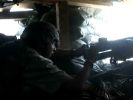Eye For Film >> Movies >> Restrepo (2010) Film Review
As Western troops finally start to pull out of Iraq, the world's attention is shifting to the problems of Afghanistan - and what, if anything, we can do about them or achieve with our Armies. Doubtless there are still many documentaries to emerge from the troubled region but this - featuring moving and extremely clear-sighted footage from filmmakers embedded with a US platoon in the Taliban stronghold of the Korengal Valley - will live long in the memory, and I'd wager on it picking up a slew of awards.
Co-directors Tim Hetherington (who was cinematographer on the almost as powerful Rwanda documentary The Devil Came On Horseback) and Sebastian Junger get what appears to be almost unfettered access as the soldiers go about their lives (and deaths) in this cockpit of violence.

If you thought The Hurt Locker came close to giving you the feeling of what it might be like to be at war and under constant threat of death, you may well find your brain reeling when, right at the start of the film, the camera captures the moment when a roadside bomb plunges the troops into battle. But this is real - and people die. One of those to lose his life early on, is the eponymous Juan "Doc" Restrepo, a lively and well-liked sort whose echo is caught on a piece of cameraphone video just a few days before the deployment that will see him bleed out from a bullet wound.
His comrades, rocked by their loss, name a ramshackle outpost after him, built to bite into Taliban territory, a move by Captain Dan Kearney, designed to encourage his men to "quit being scared". Danger is a constant companion and gunfire seems to come around almost as frequently as dinnertime. Junger and Hetherington spent a year with the platoon and the footage they have collected is remarkable, both in its variety and in its emotional impact. All life is here, from the high jinks wrestling of the youngest recruits, the mad pogo-ing up and down of some of the men to Touch Me (I Want To Feel Your Body) to the surreal sight of one solider clambering on the top of an open cliff to try to reposition his gun at the same time as attempting to have a walkie-talkie conversation with a pal about the ranch where he lived as a boy.
Mixed in with the very real threat of death are images of the equally trying difficulties of diplomacy, as Kearney attempts to win over some 'hearts and minds' in the local community - a job rendered difficult both by his predecessor's habit of killing innocent civillians and his own platoon's unfortunate "cow incident" (particularly unfortunate for the cow). Hetherington and Junger clearly have balls made of the same sort of steel as their Army counterparts, nothing else can explain how they persistently capture close-range gunfire, despite the fact that they were, presumably, as likely to catch a bullet as any of the troops.
But it isn't just on the frontline where the directorial pairing excel. They have chosen to juxtapose the Afghanistan reportage with face-hugging talking heads from the batallion survivors, recalling the incidents as they happened and acting as commentators on it. This has a two-fold benefit of breaking up the tension so that a viewer can properly consider what they have seen and of showing the men's perception of their lives and their line of work. It also serves to remind you of just how young some of these men are, a stark reality it is easy to forget.
Restrepo is non-judgemental and considering that the filmmakers spent a year with these people that is hardly a shock; embedded journalists are well known for becoming friends with their subject matter. What is surprising, however, is just how unflinching they are in their gaze on the horrors of war - there is footage here both of dead soldiers and dead civillians, caught in the crossfire.
While sentence is not being passed on the rights and wrongs of the Afghanistan push, food for thought is being served. Questions about the efficacy of these sorts of operations, the success of which seems to require a hefty slice of luck as well as planning, emerge as you watch the boys fight for their lives. And questions about the aftercare available for soldiers hang like a pall over proceedings, as one talks of an inability to sleep, another of the difficulties of adjusting back out on civvy street. After all, when you've come to take the threat of imminent 'kill or be killed' as an everyday life choice - what happens when normality is restored? Plus, in the case of the dead civillians - do the ends really justify the means?
Ever wondered what it is like to be in the Army in a warzone - to feel the heights of exhilaration in combat, the warmth of comradeship and the debilitating fear of an unseen enemy? This is probably the closest most of us are likely, or willing, to get.
Reviewed on: 23 Jan 2010
















